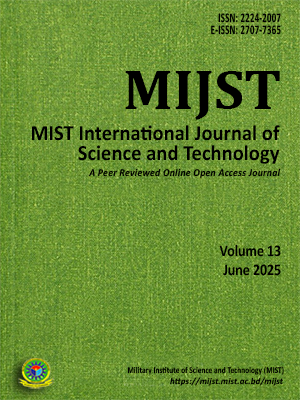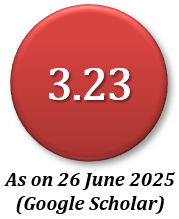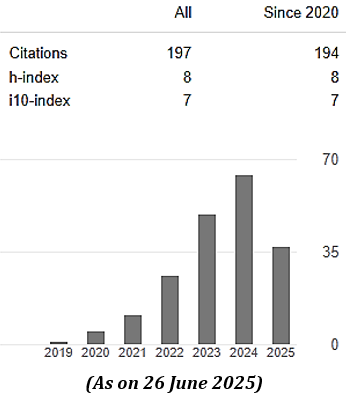Correlation Analysis of Rate of TEC Index and Spread F over North American Ionosondes
Abstract
This study investigates the diurnal, seasonal, and latitudinal variations of Spread F and the Rate of TEC Index (ROTI) over North America during the high solar activity period of 2014. Using GNSS-based ROTI measurements and Digisonde ionograms from multiple stations, we systematically analyze the relationship between Spread F occurrences and ROTI enhancements. The analysis incorporated Diurnal and seasonal variations to determine dominant trends and potential driving mechanisms, such as medium-scale traveling ionospheric disturbances (MSTIDs) and polarization electric fields. Seasonal and latitudinal variations of Spread F occurrences and ROTI fluctuations are found to be strongly linked to MSTIDs and geomagnetic activity. A clear seasonal dependence was observed at the stations situated under the transitional and mid-latitude regions of the ionosphere. The maximum irregularity occurred in April for transitional region stations and in November for mid-latitudinal stations. Additionally, Spread F and ROTI exhibit similar diurnal and seasonal trends, with maximum irregularity occurrences during nighttime (20:00–02:00 LT). A distinct seasonal dependence is observed, with transitional region stations peaking in winter and mid-latitude stations in summer. Notably, spread F was consistently associated with notable ROTI values (>0.15 TECU/min), suggesting gravity waves and polarization electric fields as driving mechanisms. Through detailed case studies, we demonstrated that MSTIDs, likely driven by gravity wave dynamics, play a crucial role in generating plasma irregularities, which in turn enhance ROTI values and contribute to Spread F formation. Under quiet geomagnetic conditions, these irregularities exhibit a strong daytime preference. Conversely, during disturbed geomagnetic conditions (e.g., the geomagnetic storm), the spatial extent of ionospheric irregularities increased significantly, affecting both transitional and mid-latitude stations for both daytime and nighttime. By demonstrating a persistent relationship between Spread F and ROTI, this study advances ionospheric modelling efforts and supports the development of improved space weather forecasting techniques, crucial for GNSS-based navigation and communication systems.
Downloads
References
Aarons, J., Basu, S. and Bushby, S.J., 1980. Latitudinal and seasonal variation of F-layer irregularities. Radio Science, 15(3), pp. 401-404.
Aarons, J., 1993. The role of the ring current in the generation or inhibition of equatorial F layer irregularities during magnetic storms. Radio Science, 28(4), pp. 469-475.
Aa, E., Huang, W., Yu, S., Liu, S., Li, J., & Zhang, S. (2020). Statistical analysis of ionospheric irregularities and scintillation during solar minimum. Journal of Geophysical Research: Space Physics, 125(8), https://doi.org/10.1029/2020JA028123.
Abdu, M.A., 2012. Equatorial spread F/plasma bubble irregularities under storm time disturbance electric fields. Journal of atmospheric and solar-terrestrial physics, 75, pp.44-56.
Alfonsi, L., De Franceschi, G., Spogli, L. and Tommaso, G.D., 2013. Ionospheric scintillations over Europe at different solar activity conditions. Journal of Space Weather and Space Climate, 3(A06).
Basu, S. and Kelley, M.C., 1979. A review of recent observations of equatorial scintillations and their relationship to current theories. Radio Science, 14(3), pp. 471-485.
Basu, S., Groves, K.M., Quinn, J.M., & Doherty, P. (1999). A comparison of TEC fluctuations and scintillations at Ascension Island. Journal of Atmospheric and Solar-Terrestrial Physics, 61(16), 1219–1226.
Basu, S., Groves, K.M., Quinn, J.M. and Doherty, P., 2001. A comparison of TEC fluctuations and scintillations at Ascension Island. Journal of Atmospheric and Solar-Terrestrial Physics, 63(9), pp. 959-964.
Basu, S., Basu, S., Groves, K.M., Weber, E.J., Sultan, P.J. and Keskinen, M.J., 2002. Characteristics of plasma structuring in the mid-latitude and equatorial ionosphere during severe magnetic storms. Journal of Geophysical Research: Space Physics, 107(A12), pp. 1-14.
Basu, S., Kudeki, E., Basu, S., Valladares, C.E., Weber, E.J., Zengingonul, H.P., Bhattacharyya, S., Sheehan, R., Meriwether, J.W., Biondi, M.A. and Kuenzler, H., 1996. Scintillations, plasma drifts, and neutral winds in the equatorial ionosphere after sunset. Journal of Geophysical Research: Space Physics, 101(A12), pp.26795-26809.
Berkner, L.V., & Wells, H.W. (1934). F-region ionosphere investigations at low latitudes. Terrestrial Magnetism and Atmospheric Electricity, 39(3), 215–230.
Blanc, M. and Richmond, A.D., 1980. The ionospheric disturbance dynamo. Journal of Geophysical Research: Space Physics, 85(A4), pp.1669-1686.
Bowman, G.G.; Monro, P.E. Mid-latitude range spread and travelling ionospheric disturbances. J. Atmos. Terr. Phys. 1988, 50, 215–223.
Bowman, G.G. (1991). Ionospheric frequency spread and its relationship with range spread in mid-latitude regions. Journal of Geophysical Research: Space Physics, 96(6), 9745–9753.
Bowman, G.G. (1998). Short-term delays (hours) of ionospheric spread F occurrence at a range of latitudes, following geomagnetic activity. Journal of Geophysical Research: Space Physics, 103(A5), 11627–11634.
Burke, W. J., Gentile, L. C., Huang, C. Y., Valladares, C. E., & Su, S.-Y. (2004). Longitudinal variability of equatorial plasma bubbles observed by DMSP and ROCSAT-1. Journal of Geophysical Research: Space Physics, 109(A12), A12301. https://doi.org/10.1029/2004JA010583.
Carter, B. A., Yizengaw, E., Pradipta, R., Retterer, J. M., Groves, K., Valladares, C., ... & Roddy, P. (2014). Global equatorial plasma bubble occurrence during the 2015 St. Patrick’s Day storm. Journal of Geophysical Research: Space Physics, 121(1), 894–905. https://doi.org/10.1002/2015JA022194.
Chandra, H., Rastogi, R.G. and Sastri, J.H., 2003. Equatorial Spread F and its latitudinal variations. Annales Geophysicae, 21(4), pp. 899-907.
Cherniak, I., Krankowski, A. and Zakharenkova, I., 2014. Observation of the ionospheric irregularities over Europe. Journal of Geophysical Research: Space Physics, 119(8), pp. 6773-6786.
Cherniak, I., Zakharenkova, I., & Krankowski, A. (2014). Approaches for modelling ionospheric irregularities based on the TEC rate index. Earth, Planets and Space, 66(1), 165.
Cherniak, I., Krankowski, A., & Zakharenkova, I. (2018). ROTI Maps: A new IGS ionospheric product characterizing the ionospheric irregularities occurrence. GPS Solutions, 22(2), 69.
Cherniak, I., Zakharenkova, I. and Redmon, R.J., 2018. Dynamics and occurrence of GPS scintillations over the high latitudes. Space Weather, 16(10), pp. 1345-1359.
Cherniak, I.; Zakharenkova, I.; Krankowski, A. IGS ROTI maps: Current status and its extension towards equatorial region and southern hemisphere. Sensors 2022, 22, 3748.
Chatterjee, D., Pathan, R. and Pallamraju, D., 2020. Response of equatorial plasma bubbles to geomagnetic storms using GNSS ROTI and ground-based airglow observations. Advances in Space Research, 66(12), pp. 2809-2822.
Das Gupta, A., Basu, S., Basu, S. and Das, S.K., 1981. Equatorial scintillations: Relationship to the development of irregularities in the post-sunset ionosphere. Journal of Atmospheric and Terrestrial Physics, 43(8), pp. 815-823.
Dabas, R.S., Reddy, B.M. and Das Gupta, A., 2003. Equatorial ionospheric irregularities and their effects on trans ionospheric propagation. Advances in Space Research, 31(3), pp. 509-518.
Dabas, R.S., Das, R.M., Sharma, K., Chopra, P. and Gwal, A.K., 2007. Ionospheric irregularities and GPS positioning errors. Advances in Space Research, 39(10), pp. 1514-1520.
Davies, K., 1990. Ionospheric radio (No. 31). Peter Peregrinus Ltd., London.
Dungey, J.W., 1956. Convective diffusion in the equatorial F region. Journal of Atmospheric and Terrestrial Physics, 9(5-6), pp.304-310.
Hunsucker, R.D., 1982. Atmospheric gravity waves generated in the high‐latitude ionosphere: A review. Reviews of Geophysics, 20(2), pp.293-315.
Huang, C.S., de La Beaujardiere, O., Roddy, P.A., Hunton, D.M., Liu, J.Y., Chen, K. and Hei, M., 2012. Statistical analysis of the zonal drift velocity of equatorial plasma bubbles observed by the C/NOFS satellite. Journal of Geophysical Research: Space Physics, 117(A5), A05317.
Huang, C.S.; Miller, C.A.; Kelley, M.C. Basic properties and gravity wave initiation of the mid-latitude F region instability. Radio Sci. 1994, 29, 395–405.
Huang, C.S, Sazykin, I., Spiro, R., Goldstein, J., Crowley, G. and Ruohoniemi, J.M., 2006. Storm‐time penetration electric fields and their effects.
Kelley, M.C., 2009. The Earth’s Ionosphere: Plasma Physics and Electrodynamics. Elsevier.
Kotulak, K., Zakharenkova, I., Krankowski, A., Cherniak, I., Wang, N., & Fron, A. (2020). Climatology characteristics of ionospheric irregularities described with GNSS ROTI. Remote Sensing, 12(16), 2634.
Kintner, P.M., Jr., Coster, A.J., Fuller-Rowell, T., Mannucci, A.J., Mendillo, M., & Heelis, R. (Eds.). (2013). Mid-latitude Ionospheric Dynamics and Disturbances. John Wiley & Sons: Hoboken, NJ, USA. Volume 181.
King, G.A.M., 1970. Spread-F on ionograms. Journal of Atmospheric and Terrestrial Physics, 32(2), pp.209-221.
Maruyama, T., & Matuura, N. (1984). Longitudinal variability of annual changes in activity of equatorial spread F and plasma bubbles. Journal of Geophysical Research: Space Physics, 89(A12), 10903–10912.
Miller, C.A.; Swartz, W.E.; Kelley, M.C.; Mendillo, M.; Nottingham, D.; Scali, J.; Reinisch, B. Electrodynamics of mid-latitude spread F: 1. Observations of unstable, gravity wave-induced ionospheric electric fields at tropical latitudes. J. Geophys. Res. Space Phys. 1997, 102, 11521–11532.
Monte-Moreno, E., Hernandez-Pajares, M., Yang, H., Rigo, A.G., Jin, Y., Høeg, P., Miloch, W.J., Wielgosz, P., Jarmołowski, W., Paziewski, J. and Milanowska, B., 2021. Method for forecasting ionospheric electron content fluctuations based on the optical flow algorithm. IEEE Transactions on Geoscience and Remote Sensing, 60, pp.1-21., doi: 10.1109/TGRS.2021.3126888.
Mrak, S.; Coster, A.; Groves, K.; Nikoukar, R. Ground-based infrastructure for observing and characterizing GNSS scintillation producing ionospheric irregularities at mid-latitudes. Bull. Am. Astron. Soc. 2023, 55, 286.
Narayanan, V.L.; Shiokawa, K.; Otsuka, Y.; Neudegg, D. On the role of thermospheric winds and sporadic E layers in the formation and evolution of electrified MSTIDs in geomagnetic conjugate regions. J. Geophys. Res. Space Phys. 2018, 123, 6957–6980.
Nguyen, C.T., Oluwadare, S.T., Le, N.T., Alizadeh, M., Wickert, J. and Schuh, H., 2021. Spatial and temporal distributions of ionospheric irregularities derived from regional and global ROTI maps. Remote Sensing, 14(1), p.10, doi: 10.3390/rs14010010.
Otsuka, Y.; Shiokawa, K.; Ogawa, T.; Yokoyama, T.; Yamamoto, M. Spatial relationship of nighttime medium-scale travelling ionospheric disturbances and F region field-aligned irregularities observed with two spaced all-sky airglow imagers and the middle and upper atmosphere radar. J. Geophys. Res. Space Phys. 2009, 114.
Otsuka, Y.; Onoma, F.; Shiokawa, K.; Ogawa, T.; Yamamoto, M.; Fukao, S. Simultaneous observations of nighttime medium-scale travelling ionospheric disturbances and E region field-aligned irregularities at mid-latitude. J. Geophys. Res. Space Phys. 2007, 112.
Otsuka, Y.; Suzuki, K.; Nakagawa, S.; Nishioka, M.; Shiokawa, K.; Tsugawa, A. GPS observations of medium-scale traveling ionospheric disturbances over Europe. Ann. Geophys. 2013, 31, 163–172.
Paul, K.S.; Haralambous, H.; Oikonomou, C.; Paul, A. Investigation of Satellite Trace (ST) and Multi-reflected Echo (MRE) ionogram signatures and its possible correlation to nighttime spread F development from Cyprus over the solar mini-max (2009–2016). Adv. Space Res. 2021, 67, 1958–1967.
Paul, K.S.; Haralambous, H.; Oikonomou, C.; Paul, A.; Belehaki, A.; Ioanna, T.; Kouba, D.; Buresova, D. Multi-station investigation of spread F over Europe during low to high solar activity. J. Space Weather Space Clim. 2018, 8, A27.
Paul, K.S.; Haralambous, H.; Oikonomou, C.; Paul, A. Long-term aspects of nighttime spread F over a low mid-latitude European station. Adv. Space Res. 2019, 64, 1199–1216.
Paul, K.S.; Haralambous, H.; Singh, A.K.; Gulyaeva, T.L.; Panchenko, V.A. Mid-latitude Spread F, long-term occurrence characteristics as a function of latitude over Europe. Adv. Space Res. 2022, 70, 710–722.
Paul, K.S.; Haralambous, H.; Oikonomou, C.; Singh, A.K.; Gulyaeva, T.L.; Panchenko, V.A.; Altadill, D.; Buresova, D.; Mielich, J.; Verhulst, T. A mid-latitude spread F over an extended European area. J. Atmos. Sol.-Terr. Phys. 2023, 248, 106093.
Paul, K.S., Rafi, M.H., Haralambous, H. and Mostafa, M.G., 2024. Assessing ionospheric irregularity differences over Europe using ROTI and ionosonde data. Atmosphere, 15(1), p.120001.
Perna, L., Belehaki, A. and Zolesi, B., 2018. Ionospheric irregularities over Europe as derived from GNSS data. Annales Geophysicae, 36(5), pp. 1243-1254.
Perkins, F., 1973. Ionospheric irregularities. Reviews of Geophysics, 11(4), pp. 779-822.
Pi, X., Mannucci, A.J., Lindqwister, U.J., & Ho, C.M. (1997). Monitoring of global ionospheric irregularities using the worldwide GPS network. Geophysical Research Letters, 24(19), 2283–2286.
Reinisch, B.W.; Galkin, I.A. Global ionospheric radio observatory (GIRO). Earth Planets Space 2011, 63, 377–381.
Shimazaki, T. A statistical study of occurrence probability of spread F at high latitudes. J. Geophys. Res. 1962, 67, 4617–4634. Atmosphere 2024, 15, 331 17 of 17 34.
Tiwari, R., Strangeways, H.J., Tiwari, S., & Ahmed, A. (2013). Investigation of ionospheric irregularities and scintillation using TEC at high latitude. Advances in Space Research, 52(6), 1111–1124.
Tsunoda, R. T. (1985). Control of the seasonal and longitudinal occurrence of equatorial scintillations by the longitudinal gradient in integrated E region Pedersen conductivity. Journal of Geophysical Research: Space Physics, 90(A1), 447–456.
Vadakke Veettil, S., Haralambous, H., & Aquino, M. (2017). Observations of quiet-time moderate mid-latitude L-band scintillation in association with plasma bubbles. GPS Solutions, 21(3), 1113–1124.
Wang, Z., Shi, J.K., Torkar, K., Wang, G.J., & Wang, X. (2014). Correlation between ionospheric strong range spread F and scintillations observed in Vanimo station. Journal of Geophysical Research: Space Physics, 119(10), 8578–8585.
Yang, Z.; Liu, Z. Correlation between ROTI and Ionospheric Scintillation Indices using Hong Kong low-latitude GPS data. GPS Solut. 2016, 20, 815–824.
Ye, H.; Yi, W.; Zhou, B.; Wu, J.; Yu, B.; Tian, P.; Wang, J.; Long, C.; Lu, M.; Xue, X.; et al. Multi-Instrumental Observations of Mid-latitude Plasma Irregularities over Eastern Asia during a Moderate Magnetic Storm on 16 July 2003. Remote Sens. 2023, 15, 1160.
Yokoyama, T.; Hysell, D.L.; Otsuka, Y.; Yamamoto, M. Three-dimensional simulation of the coupled Perkins and Es-layer instabilities in the nighttime mid-latitude ionosphere. J. Geophys. Res. Space Phys. 2009, 114.
Zakharenkova, I., Astafyeva, E., & Cherniak, I. (2020). Ionospheric irregularities and scintillations during geomagnetic storms: Role of the auroral oval expansion. Space Weather, 18(6), e2020SW002503. https://doi.org/10.1029/2020SW002503.
Zhang, S., Liu, J.Y., Yue, J., and Zhao, B., 2015. Longitudinal and seasonal variation of ionospheric disturbances. Journal of Geophysical Research: Space Physics, 120(7), pp. 6443-6462.
MIJST follows the open access policy.

This work is licensed under a Creative Commons Attribution-NonCommercial 4.0 International License. This allows anyone to copy, share, distribute, and modify the work for non-commercial purposes, where the original work and source should be properly credited.
















